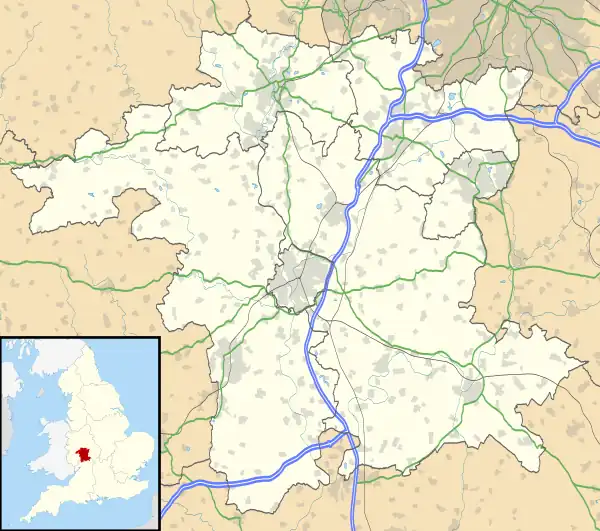| Worcester Guildhall | |
|---|---|
 | |
| Location | Worcester, Worcestershire |
| Coordinates | 52°11′28″N 2°13′15″W / 52.1912°N 2.2208°W |
| Built | 1723 |
| Architect | Thomas White |
| Architectural style(s) | Queen Anne style |
Listed Building – Grade I | |
| Designated | 22 May 1954 |
| Reference no. | 1389921 |
 Location of Worcester Guildhall in Worcestershire | |
The Worcester Guildhall is a municipal building in the High Street, Worcester, England. It is a Grade I listed building.[1]
History
The first guildhall on the site was a timber-framed structure constructed as a meeting place for local merchants in about 1227.[2] In 1717 civic leaders decided to replace the building with a grander structure.[3]
The current building, designed by Thomas White in the Queen Anne style, was completed in 1723.[1] The design involved a central bay and two wings with the central bay being flanked by two full-height Composite order columns with a pediment above displaying flute-playing cherubs and the Royal Arms.[1] At roof level, above the cornice, carved figures of Justice, Peace, Plenty, Chastisement and Hercules were erected together with four urns.[1] At ground floor level in the middle of the central bay was the main entrance which was flanked by Composite order columns with a fanlight and architrave above.[1] On either side of the entrance, statues of King Charles I and King Charles II were erected in niches; at first floor level, above the main entrance a statue of Queen Anne was erected, also in a niche.[1] Inside, a court room and a lower hall were established on the ground floor, and a council chamber and a large imposing assembly room were established on the first floor.[2] King George III described the assembly room as "a handsome gallery" when he visited it in August 1788.[4]
The building was used for cultural events: the Three Choirs Festival, which involved concerts given by the choirs of Gloucester, Hereford and Worcester, was regularly held there until the mid-18th century.[5] In the 18th century, Worcester also elected its members of Parliament at the Guildhall, a minimum requirement being that they should own freehold property worth 40 shillings a year; the decision was made by the loudest shouting rather than raising of hands.[6] The court room was used a facility for dispensing justice and accommodated the crown court and nisi prius court.[1] Citizens were given the privilege of being imprisoned underneath the Guildhall rather than in the town jail, except for the most serious offences.[6]
Sir Winston Churchill was presented with the Freedom of the City of Worcester at the Guildhall on 20 May 1950.[7] The Guildhall was the headquarters of the county borough of Worcester for much of the 20th century and, following the implementation of the Local Government Act 1972,[8] became the meeting place of enlarged Worcester City Council.[9] Queen Elizabeth II, accompanied by the Duke of Edinburgh, attended a reception at the Guildhall in July 2012, before undertaking a walkabout outside the building.[4]
Works of art in the Guildhall include portraits by Christopher William Hunneman of King George III[10] and of his wife, Queen Charlotte[11] and a portrait by James Sant of Queen Victoria.[12]
Gallery
 The Assembly Room
The Assembly Room The Lower Hall
The Lower Hall The Council Chambers
The Council Chambers The Court Room
The Court Room The Mayors Parlour Room
The Mayors Parlour Room
References
- 1 2 3 4 5 6 7 Historic England. "Guildhall, Worcester (1389921)". National Heritage List for England. Retrieved 23 August 2019.
- 1 2 "Worcester Guildhall". Discover Worcestershire. Retrieved 24 August 2019.
- ↑ "Worcester Guildhall". Britain Express. Retrieved 24 August 2019.
- 1 2 "The Queen comes to Worcester: Interesting facts about the visit". ITV. 11 July 2012. Retrieved 15 August 2020.
- ↑ Wollenberg, Susan; McVeigh, Simon (2017). Concert Life in Eighteenth Century Britain. Routledge. p. 22. ISBN 978-1138245440.
- 1 2 Willis-Bund, J W; Page, William, eds. (1924). "The city of Worcester: Introduction and borough". A History of the County of Worcester: Volume 4. London: British History Online. pp. 376–390. Retrieved 20 May 2018.
- ↑ "Freedom of the City of Worcester" (PDF). Worcester Civic Society. 2016. p. 3. Retrieved 15 August 2020.
- ↑ Local Government Act 1972. 1972 c.70. The Stationery Office Ltd. 1997. ISBN 0-10-547072-4.
- ↑ "Council Agenda" (PDF). Worcester City Council. 18 February 2020. Retrieved 3 July 2020.
- ↑ Hunneman, Christopher William. "George III (1738–1820)". Art UK. Retrieved 15 August 2020.
- ↑ Hunneman, Christopher William. "Queen Charlotte (1744–1818)". Art UK. Retrieved 15 August 2020.
- ↑ Sant, James. "Queen Victoria (1819–1901)". Art UK. Retrieved 15 August 2020.